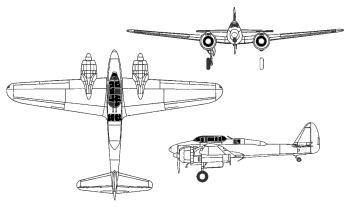



The Nakajima J1N 'Irving' was developed by K. Nakamura as a twin-engined long-range naval escort fighter for the IJN's shore-based operations. Prototypes were extremely maneuverable (even capable of dogfighting with a Zero) but were later shown to have a number of shortcomings mostly related to its armament, hydraulic system, propellers, and weight. As a result, its remotely controlled dorsal barbettes were removed and the aircraft entered service as a reconnaissance platform with a slightly redesigned fuselage and a third crew member. Nevertheless, combat experience by the 251st Air Corps (and its commander Yasuna Kozono) led to its adoption as a night fighter with with upper and lower pairs of oblique cannon. This new aircraft, known as the Gekko (Moonlight), was used in the Southwest and Central Pacific against Allied bombers but was not capable of intercepting the fast, high-flying B-29s. As a result, most ended up as kamikazes.
Conceived as early as 1938, the prototype J1N1 did not fly until May 1941 and was only built in limited numbers as an escort fighter, reverting to a reconnaissance platform known as the J1N1-C which was later redesignated as the J1N1-R. Night fighter conversions included the J1N1-C-KAI before the development of a dedicated aircraft for this role, the J1N1-S Gekko, which entered service in 1943 and was produced as the J1N1-Sa with the removal of the lower oblique cannon.
Preceded by:
NoneSucceeded by:
None | |
| Design | J1N1-S |
| Name | Gekko |
| Code Name | Irving |
| Type | Night Fighter |
| Year | 1943 |
| Crew | 2-3 |
| Dimensions | |
| Length | 39 ft 12 in |
| Height | 14 ft 12 in |
| Wing Span | 55 ft 9 in |
| Wing Area | n/a |
| Weight | |
| Empty | 10,670 lbs |
| Maximum | 18,043 lbs |
| Wing Loading | 41.9 lb/ft² |
| Performance | |
| Speed | 315 mph |
| Ceiling | 30,610 ft |
| Range | 1,585-2,330 mi |
| Powerplant | |
| Engine | 2 x NK1F Sakae 21 Nakajima 1,130 hp |
| Thrust/Weight | 0.42 |
| Armament | |
| Guns | 4 x 20-mm |
| Payload | - |
| Production | |
| Built | 420 |
| Total | 479 |